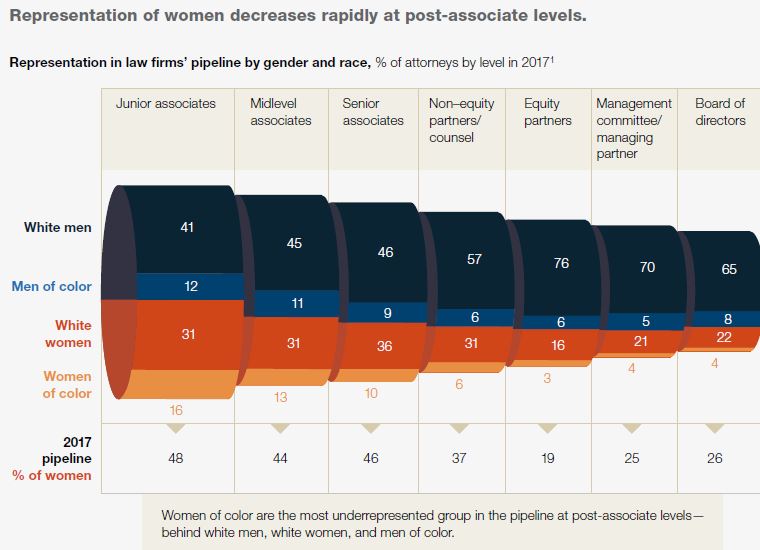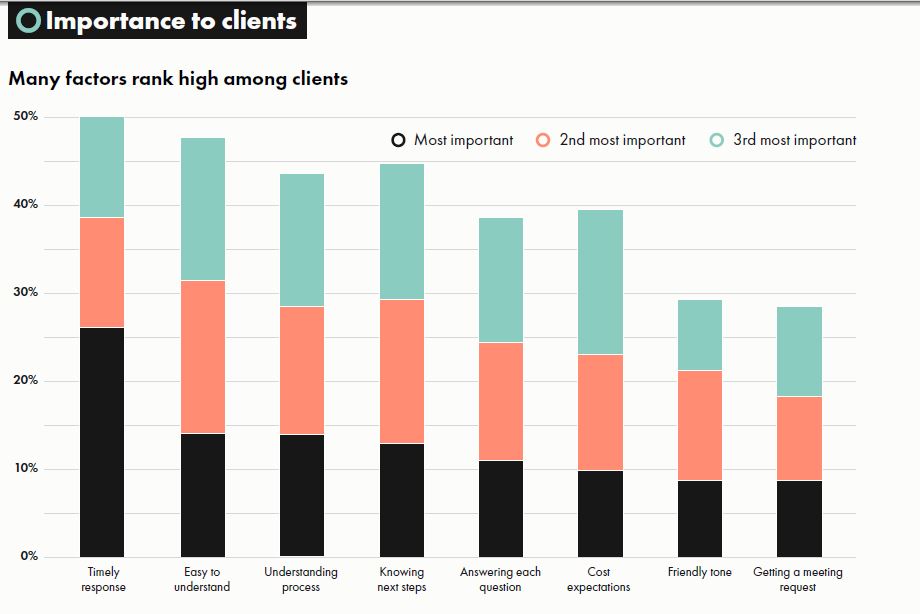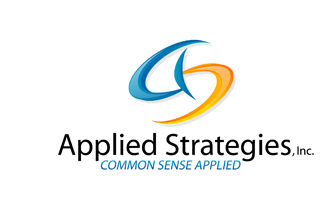Wishes for Canadian Law Firms in 2020While counterintuitive and not said as a business development promo, my hope for law firms in 2020 is that you make mistakes. Neil Gaiman said, "if you are making mistakes, then you are making new things, trying new things, learning, living, pushing yourself, changing yourself, changing your world. You're doing things you've never done before, and more importantly, you're doing something".If your firm is to be successful in 2020 and beyond, there are challenges your firm needs to change how they approach them. What are these challenges you might ask? There is a commonality in the challenges faced by firms, but because there are no "cookie-cutter" solutions (beware of anyone pitching you that there is), the priority will vary from firm to firm. The challenges are not in any particular order. Gender Diversity Issue is A Firm Issue, not a Women's Issue Chart 1 - Source Catalyst – Women in Law: Quick Take - October 2018
Chart 2 - Source - McKinsey & Company - Women in law firms - October 2017 (Click image for larger version.) Total % of women and men per level in race and gender pipeline may not sum to overall pipeline totals, as the race pipeline only includes firms that were able to supply race data. Due to rounding, representation by race may sum to 101 within some levels. In case you think this is a temporary situation, below is the enrolment profile for University of Toronto Law School's first-year classes over a 5-year period:
A law firm's short-term profitability is driven in part by the quality of the lawyers it attracts. A law firm's long-term profitability is driven in large part by the quality of the lawyers it retains. It is not a stretch to anticipate that this higher percentage results in a higher percentage of the best and brightest being female. So, what is your firm doing to protect its long-term profitability? Productivity Disruptors Several major legal industry reports in 2018 and 2019 have indicated a flattening of the billable hours docketed. One of the most recent ones (the US of course) indicated an average of 120 hours a month, a 15 – 20 hour a month decline over the last ten years or so. This decline is in the face of increased costs (salaries and technology), and the flattening rate increases causing a direct squeeze on the income available to partners.Some firms have opted to blame it on millennials and a lack of “fire in the belly” or “commitment” and so on. However, some other explanations your firm should explore before opting for laying the blame at the “feet of a generational issue” includes:
Debt Adversity Growth in partners' capital has caused an imbalance in debt to equity ratios. And you might ask, how is this a bad thing? Several developments are converting what was seen by some (clearly your bankers) as a positive to a negative including:
One prudent approach to avoid such a problem is to pick a certain date when the repayment of the capital account begins. It should be while the partner is still active, and it is over an extended time frame (e.g., start in their late '50s, over an 8 – 10-year period. To create a sense of fairness for disproportionate partner capital accounts, interest at the same rate that the firm borrows at should be paid on the permanent capital account. Permanent capital is the monies that Partners invest in the partnership permanently until they leave the partnership versus temporary capital - this is the amount of a partner's undrawn share of their share of the partnership's income and is normally just a temporary situation). Find Effective Compromise with the Millennials' Perspective With both acknowledged and unacknowledged change (the “ostrich factor”) that is going on in the legal profession, it is amazing (and perhaps decidedly sad) that Millennials are just the next generation of lawyers to raise the same concerns or issues. Perhaps Crystal Kadakia captured it best in her book The Millennial Myth: Transforming Misunderstanding Into Workplace Breakthroughs:
The real difference is not as much as in the firm's handling of the concerns but rather in the Millennials' lower tolerance to accept non-responsiveness to these concerns. There is a clear indication that "risk aversion" has been redefined for Millennial lawyers. In effect, the likelihood of becoming a partner has changed so much so that the risk of losing "marketability" is greater. Therefore, in-attentiveness to their concerns results in a demonstrated willingness to change firms or careers. Hopefully, I need not remind firms of their “real financial investment” in this generation of lawyers and the absolute lack of return when they leave or are driven out. Such departures also have a direct impact on the ability to pay out retiring partners' capital accounts. Dr. Larry Richard has done extensive research into the self-rationalization of lawyers. He identified the four needs of Millennial lawyers that must be addressed to maximize the leverage of them by firms:
Implementing these simple needs has been more difficult than one should expect, but to not do so jeopardizes a firm's long-term success. Demand accountability
The lack of accountability stems from the “cult of the individual.” Be that as it may, I would boil it down to the “exception is the rule” culture – which permeates many a firm. The Paradox of Growth for Law Firms On the one hand, law firms say they want to grow their revenue yet seem to have trouble finding business. On the other hand, clients continue to struggle, finding help with their legal problems. Why hasn't the normal laws of supply and demand addressed this paradox – poor client service. With occasional small variations, the following findings are consistently identified in studies of clients of what they are looking for in client service from their lawyer/law firm. Chart 3 - Source - Clio - Legal Trends Report - 2019 (Click image for larger version.) The gap between what clients want and what they get is embarrassing and a direct factor in the continuation of the paradox. CLIO conducted one of the more recent studies. Their study assessed the client services provided by 1,000 randomly selected law firms in the United States. In addition to emailing the 1,000 firms, they phoned 500 of these firms. They tailored their outreach to correspond with the type of law practiced by each firm, across five different issue types:
There were three simple qualifications to be a law firm included in the study:
Response to Email Inquiries:
They also did a similar telephone test of law firms, and of the 279 respondings, over 60% of them did not meet the criteria for more than half of the performance drivers (including simply returning the call). If you want to grow your firm, make sure your talk matches your walk – because what people are saying about you is critical as referrals (friends, lawyer, and non-legal professionals) are still, by some distance, the number one way clients select lawyers. The Other Succession Planning Ineffective client/practice transition planning has caused the collapse of some law firms. However, many more have collapsed due to a lack of firm management transition planning (this includes key administrative/operational positions). The eight steps of a management transition framework include:
Conclusion Again, I could attempt to develop something clever and on target, but Denis Waitley captures what the mantra should be for law firms in 2020 and beyond.
Stephen Mabey is a CPA, CA and the Managing Director of Applied Strategies, Inc. Stephen's focus is on law firms in general and on small to medium size law firms in particular. He has written about and advised on, a wide range of issues including - leadership, business development, marketing, key performance indicators, strategic planning, mergers, practice acquisitions, competitive intelligence, finance, mergers, practice transitioning, compensation, organizational structures, succession and transition planning, partnership arrangements and firm retreats. In 2013, Stephen was inducted as a Fellow of the College of Law Practice Management in recognition of his sustained commitment to the highest standards of professionalism in law practice management. For more information, visit appliedstrategies.ca or connect with Stephen Mabey on LinkedIn. |



